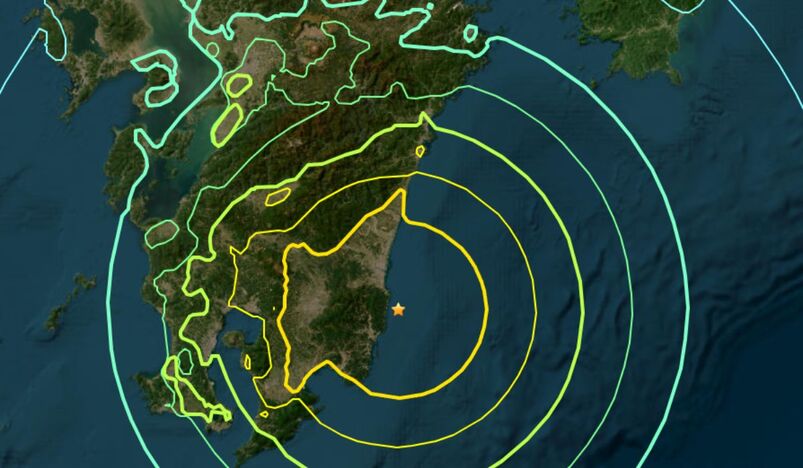
Japan Issues its First Ever Mega Quake Warning
After a 7.1-magnitude earthquake struck Japan's southern islands on Thursday, the country's meteorological agency issued a grave warning: A larger earthquake could be imminent, with the risk being particularly high over the next week.
In its first-ever "megaquake advisory," the agency noted an increased likelihood of strong shaking and a tsunami, particularly along the Nankai Trough, a subduction zone capable of generating magnitude 8 or 9 earthquakes. Residents in the area were urged to prepare accordingly.
The advisory wasn't a precise prediction but rather a forecast of heightened risk, reflecting advancements in seismologists' understanding of subduction zone earthquakes.
A dangerous subduction zone
The Nankai Trough is an underwater subduction zone where the Eurasian Plate converges with the Philippine Sea Plate, pushing the latter beneath the former and into the Earth's mantle.
Subduction zone faults accumulate stress, and a megathrust earthquake occurs when a locked fault slips, releasing this stress. The term "megaquake" is a shortened form of this phenomenon. These zones are known to produce the most powerful earthquakes in Earth's history.
The Pacific "Ring of Fire" is made up of multiple subduction zones. In the U.S., the Cascadia subduction zone extends along the West Coast from Vancouver Island in Canada to Cape Mendocino in California.
The Nankai Trough fault in Japan consists of several segments, but if the entire fault were to slip simultaneously, Japanese scientists believe it could trigger an earthquake as powerful as magnitude 9.1.
In the event of a megaquake near Japan, the Philippine Sea Plate would shift, potentially moving 30 to 100 feet near Japan's southeast coast, resulting in intense shaking.
This vertical movement of the seafloor would also generate a tsunami, sending waves toward Japan's coast. According to estimates from Japanese scientists published in 2020, these waves could reach nearly 100 feet in height.
A History of Significant Earthquakes
The Nankai Trough has historically produced large earthquakes approximately every 100 to 150 years, according to a study from last year. In January 2022, Japan’s Earthquake Research Committee estimated a 70% to 80% chance of a megathrust earthquake occurring within the next 30 years.
These major earthquakes along the Nankai Trough often occur in pairs, with the second quake typically following within two years. The most recent examples of this pattern were the "twin" earthquakes of 1944 and 1946.
This pattern occurs because the fault is segmented; when one segment slips, it can increase stress on another segment.
Thursday's magnitude-7.1 earthquake occurred on or near this subduction zone, according to the United States Geological Survey.
Harold Tobin, a professor at the University of Washington who has studied the Nankai Trough, noted that this recent quake took place in a segment that experiences frequent seismic activity. Regular earthquakes in this area can help release stress, reducing the likelihood of this specific segment producing a large quake. However, there is concern about the quake’s proximity to another segment that has been accumulating stress since the 1940s.
"It’s adjacent to the western Nankai region, and that’s clearly locked up. That’s the reason for the alert and concern," Tobin explained.
A Forecast, Not a Prediction
While scientists cannot predict earthquakes, they are improving their ability to forecast periods of increased risk, especially in well-monitored regions like Japan.
Japanese authorities are advising residents to prepare by reviewing evacuation routes and staying alert for potential future warnings.
Even though the risk of a large earthquake is elevated, this does not mean one will occur soon. According to a study from last year, the Japanese government’s guidelines suggest that the likelihood of a large earthquake occurring within a week of a magnitude-7 quake is roughly “once per a few hundred times.”
The most probable outcome is that the recent seismic activity will not trigger anything significant, despite the heightened probability of a large earthquake.
"We might wait decades before Nankai has another earthquake," Tobin noted.
A Known Danger
In 2011, a large section of the seafloor, roughly the size of Connecticut, suddenly shifted, causing a magnitude-9.1 earthquake—the third-largest recorded worldwide since 1900. This megathrust earthquake triggered a devastating tsunami off Japan's eastern coast, leading to over 18,000 deaths, according to the U.S. National Oceanic and Atmospheric Administration.
Following this disaster, the Japanese government revised its natural disaster scenarios in 2012, estimating that up to 323,000 people could die in a worst-case scenario earthquake on the Nankai Trough, primarily due to tsunamis.
Similarly, the Cascadia Subduction Zone off the U.S. West Coast poses a comparable risk, although megathrust earthquakes are expected there less frequently—approximately every 300 to 500 years. This fault is capable of producing a magnitude-9.1 earthquake and generating tsunami waves up to 80 feet high. Recent detailed mapping of the fault revealed that it is divided into four segments.
.jpg)
Qatar Secures Place Among the World's Top 10 Wealthiest Nations
.jpg)
Hamad International Airport Witnesses Record Increase in Passenger Traffic

Saudi Arabia: Any visa holder can now perform Umrah

What are Qatar's Labour Laws on Annual Leave?
Leave a comment